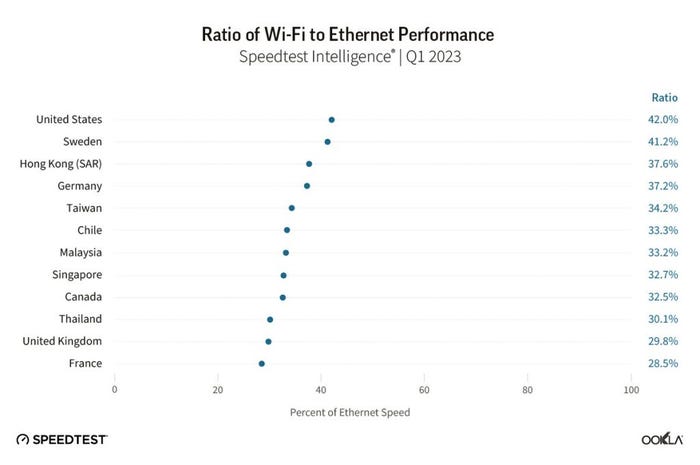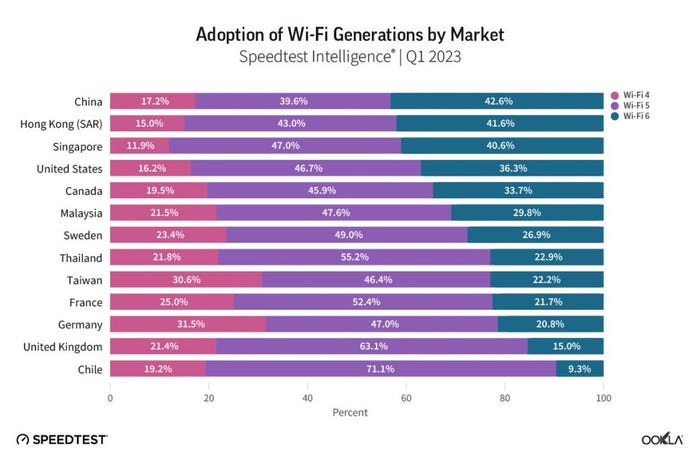UK wifi speeds clocking in at 29.8% of ethernet speeds
A report by Ookla says ISPs need to do more to improve home wifi as performance continues to lag behind ethernet in many advanced fixed broadband markets, with the UK near the bottom of the charts.
May 17, 2023

A report by Ookla says ISPs need to do more to improve home wifi as performance continues to lag behind ethernet in many advanced fixed broadband markets, with the UK near the bottom of the charts.
The report points out the UK is one of the worst effected – the gap between ethernet and wifi performance has widened by 11.6% in the last year, with wifi now clocking in at 29.8% of ethernet speeds. Globally it ranges between 30-40%.
ISPs in advanced fixed broadband markets are in the process of offering more advanced wifi routers and things such as mesh networks we’re told, with Canada, France, Germany, Singapore, Sweden, and the US are held up as successfully examples of this over the past year. However, Ookla says more needs to be done.

Adoption of newer wifi technology standards is a key driver of performance improvements, as you’d expect – however the report says older generations of wifi 4 and wifi 5 remain dominant globally, while wifi 6 represents under 10% of the instal base as of February 2023, and there were very few wifi 7 samples.
ISPs are the main driver behind the adoption of new wifi standards according to a further cited report, and in terms of which regions are good at rolling wifi 6 out, Asia led the way with China and Hong Kong both recording 42% adoption, followed by Singapore with 37%. North America showed the next highest adoption levels, with the US and Canada recording 32% and 30% respectively. European markets fared less well, with adoption ranging from 13% in the UK to 24% in Sweden.

The report highlights 6 GHz spectrum allocation as key to capitalising on the newer generations, saying:
“To capture the full performance benefits of Wi-Fi 6E and Wi-Fi 7, countries must allocate 6 GHz spectrum for unlicensed use, therefore allowing Wi-Fi devices to access this higher frequency, higher capacity spectrum, and utilize wider channels. At present, according to the Wi-Fi Alliance, allocation of the lower portion of the 6 GHz spectrum band (5,925 MHz to 6,425 MHz) is common among developed economies, with some notable exceptions in some developed markets in Asia and Asia Pacific, in particular China, while allocation of the full 6 GHz band is more limited, available across North America and some Latin American markets, as well as Saudi Arabia and South Korea.”
However the prices of wifi 7 routers are identified in the report as a barrier to entry for many, citing TP-link’s flagship model Archer BE900’s retail price of $699.99. Furthermore since even the latest high end phones such as the Samsung Galaxy S23 and the Apple iPhone 14 as yet don’t support wifi 7, the report says: “It’s clear that, for now, ISPs should prioritize the rollout of Wi-Fi 6/6E among their customer bases rather than consider leapfrogging to Wi-Fi 7.”
In a nutshell, the report concludes that that ISPs need to do more to improve the customer experience regarding home wifi, and that should be done via a mix of increased wifi 6 routers bolstered by mesh networking products.
Outside of performance hungry gamers, plugging devices into ethernet ports at home is probably quite a rare thing, so one takeaway would seem to be the average user isn’t getting the speeds that are there to be had from their beefy new fibre contracts, especially so in the UK.
Get the latest news straight to your inbox. Register for the Telecoms.com newsletter here.
About the Author(s)
You May Also Like











_1.jpg?width=700&auto=webp&quality=80&disable=upscale)


.png?width=800&auto=webp&quality=80&disable=upscale)